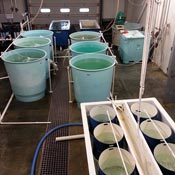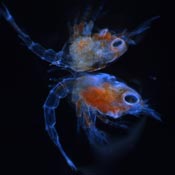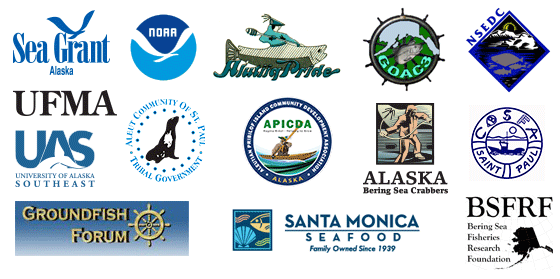2015 king crab culture at Alutiiq Pride Shellfish Hatchery
 Hatchery setup for red king crab larvae. Asia Beder photo. Click image for larger version [720 x 960 px, 114 KB].
Hatchery setup for red king crab larvae. Asia Beder photo. Click image for larger version [720 x 960 px, 114 KB]. Red (top) and blue king crab zoeae 1 larvae. Asia Beder photo. Click image for larger version [2048 x 1536 px, 114 KB].
Red (top) and blue king crab zoeae 1 larvae. Asia Beder photo. Click image for larger version [2048 x 1536 px, 114 KB].King crab larvae are growing this spring at the Alutiiq Pride Shellfish Hatchery in Seward. Red king crab egg-bearing females (broodstock) were captured in pots in Alitak Bay on Kodiak Island, and transported to the NOAA lab in Kodiak before being shipped to Seward. Larvae hatching began in early March, and biologists stocked over 400,000 larvae in 1200 liter tanks during that month. Larvae from many females are being raised to maximize the genetic diversity of larvae reared at the hatchery. Larvae eat enriche Artemia and microalgae. After molting to the first juvenile stage, crabs will be sent to Kodiak for the third year of experimental release of hatchery-raised juveniles to the natural environment, for the purpose of learning more about release strategies and natural dispersion.
Blue king crab larvae are also being raised this spring. Broodstock were collected near St. Matthew Island and sent to the hatchery in Seward. When hatching began in mid March, 15,000 larvae were stocked into rearing tanks. Blue king crab have fewer offspring than red king crab. A second difference is that the egg-bearing females incubate their embryos for two years instead of one. Monitoring of embryo development and female behavior will continue this summer with two females that will hatch their larvae next year.
News Flash is edited by Asia Beder and Ginny Eckert. AKCRRAB, the Alaska King Crab Research, Rehabilitation and Biology Program, is sponsored by Alaska Sea Grant, UAF School of Fisheries and Ocean Sciences, NOAA Fisheries, the Alutiiq Pride Shellfish Hatchery, community groups, and industry members.

